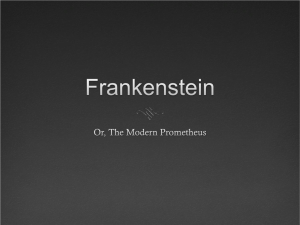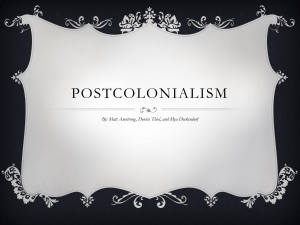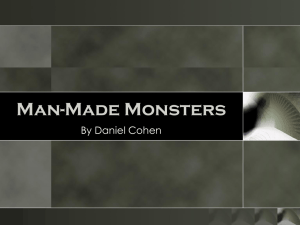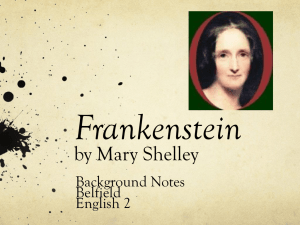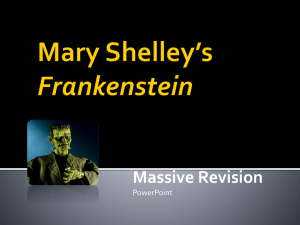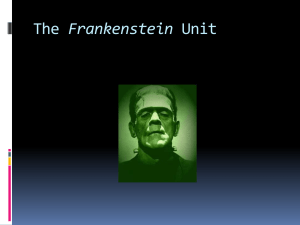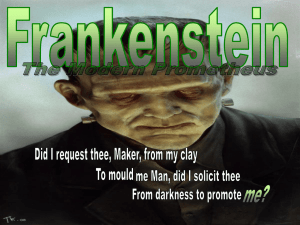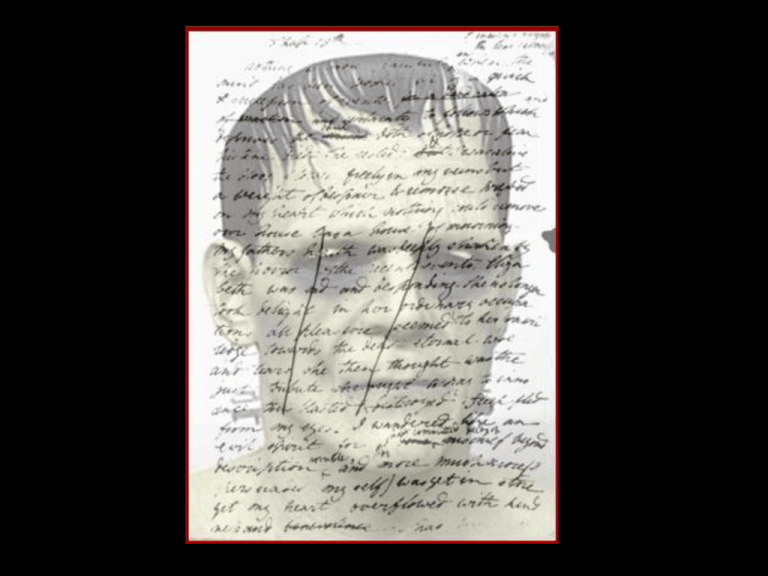
Frankenstein: The Modern
Prometheus
Preface
Mary Shelley subtitled her novel "The Modern Prometheus."
According to the Greeks, Prometheus, a Titan who preceded the
Olympian Gods, created Man from clay. Zeus demanded food
offerings from Man, but Prometheus taught them how to trick
Zeus into accepting the less useful parts of a butchered animal
so that Man could keep the best parts for themselves. Once
Zeus learned of the deception he decreed that Man was not to be
allowed fire. Prometheus crept into the underworld, stole fire
from Hephaestus, and gave it to Man. Again, Zeus discovered
the transgression and chained Prometheus to a rock, where an
eagle would devour his liver every day (it would grow back every
night). He remained there for 30,000 years.
Frankenstein: The Modern
Prometheus
In order to punish Man, Zeus and the Olympians created
Woman. A beautiful creature, Pandora was offered as a gift and
readily accepted by Man. As a “wedding present,” Zeus
presented them with a beautifully wrought box. When Pandora
opened the box, all suffering and despair was unleashed upon
mankind. Zeus had his revenge.
Prometheus sought fire for human betterment -- to make tools
and warm hearts -- but inadvertently brought about destruction.
Similarly, Mary Shelley's arrogant scientist, Victor Frankenstein,
claims "benevolent intentions, and thirst[s] for the moment
when I should put them in practice." Frankenstein endures not
only because of its infamous horrors but for the richness of the
ideas it asks us to confront--human accountability, social
alienation, and the nature of life itself.
Prometheus Bound, 1611-1612, Peter Paul Rubens (1577-1640)
Photographic reproduction of an oil painting, The Granger Collection, New York
In Frankenstein, the intelligent and sensitive monster
created by Victor Frankenstein reads a copy of Milton's
Paradise Lost, which profoundly stirs his emotions. The
monster compares his situation to that of Adam. Unlike
the first man who had "come forth from the hands of
God a perfect creature," Frankenstein's creature is
hideously formed. Abandoned by Victor Frankenstein,
the monster finds himself "wretched, helpless, and
alone."
The Expulsion from Eden, 17th century, Artist unknown.
Photographic reproduction of a line engraving. The Granger
Collection, New York
Surrounded by Ice
Frankenstein opens with a series of letters written by
Arctic explorer Robert Walton, engaged in a personal
quest to expand the boundaries of the known world. It is
Walton who first encounters Victor Frankenstein in the
Arctic desperately searching for the monster he has
created. The explorer becomes the only person to hear
Victor Frankenstein's strange and tragic tale.
Untitled, 1827. Artist unknown. Photographic reproduction of an
engraving from Northern Exposure, 1827. Picture Collection, The
Branch Libraries, The New York Public Library
The Spark of Life
In Mary Shelley's day, many people regarded the new
science of electricity with both wonder and astonishment.
In Frankenstein, Shelley uses both the new sciences of
chemistry and electricity and the older Renaissance
tradition of the alchemists' search for the elixir of life to
conjure up the Promethean possibility of reanimating the
bodies of the dead.
Unveiling the Recesses of Nature
By the early nineteenth century, philosophers like physician
Erasmus Darwin and chemist Humphrey Davy, both well known
to Mary Shelley, pointed the way to mastery of the physical
universe. Discoveries about the human body and the natural
world promised the dawn of a new age of medical power, when
such things as reanimation of dead tissue and the end of death
and disease seemed within reach.
"The Anatomy Lecture of Dr. Nicolaes Tulp" [1632] by
Rembrandt van Rijn.
Midnight Labors
“
With feverish excitement, Victor
Frankenstein pursues nature to her hiding
places. By moonlight, he gathers the body
parts he needs by visits to the graveyard,
to the charnel house, to the hospital
dissecting room and the slaughterhouse.
Although he finds his solitary
preoccupation repulsive, he is not
deterred from his quest to restore life.
There Stalked a
Multitude of
Dreams, 1969
Federico
Castellon
Hideous Progeny
Overcome by the horror of what he has
done, Victor Frankenstein abandons the
"miserable monster" he fathered in his
laboratory.
That evening a nightmare disturbs his
sleep; Elizabeth, his fiancée, becomes in
his arms the decaying corpse of his own
dead mother. The next morning when he
returns to his "workshop of filthy creation,"
the monster has escaped.
Untitled, 1779. J.F. Declassan. Photographic reproduction of an illustration
from Jacques Gamelin (1739-1803), Nouveau Recueil d'Osteologie et de
Myologie, 1779. National Library of Medicine Collection
Poor, Helpless, Miserable Wretch
“
Mary Shelley gave her monster feelings
and intelligence. Fatherless and
motherless, the monster struggles to find
his place in human society, struggles with
the most fundamental questions of identity
and personal history. Alone, he learns to
speak, to read, and to ponder "his
accursed origins." All the while, he suffers
from the loneliness of never seeing anyone
resembling himself.
Madness, or A Man Bound with Chains. Artist unknown. Photographic
reproduction from an illustration from Sir Charles Bell (1774-1842), Essays on
the Anatomy of Expression in Painting, 1806. National Library of Medicine
Collection
Remaining Silent
Abandoned by his creator, the monster
takes his revenge on Victor Frankenstein
by killing his younger brother, William.
Frankenstein's silence, in the face of the
monster's murderous actions, exacts a
terrible price. His self-imposed isolation
from society mirrors the social isolation
the monster experiences from all who see
him. Frankenstein's decision to remain
silent about the monster leads to further
tragedy.
Finis, 1733. Artist unknown. Photographic reproduction of an engraving from
William Cheselden (1688-1752), Osteographia, or, The Anatomy of the Bones,
1733. National Library of Medicine Collection
A Monstrous Mate
“I demand a creature of another sex, but as hideous as myself… It is
true, we shall be monsters, cut off from all the world; but on that
account we shall be more attached to one another. Our lives will not
be happy, but they will be harmless, and free from the misery I now
feel. Oh! my creator, make me happy; let me feel gratitude toward you
for one benefit! Let me see that I excite the sympathy of some
existing thing; do not deny me my request!”
- The Monster to Victor Frankenstein
Frankenstein; or, The Modern Prometheus, 1818
Victor Frankenstein initially agrees to create a mate for his monster.
But as Frankenstein begins to assemble an Eve for his Adam, he
grows terrified by the prospect that this female creature will be "ten
thousand times more malignant" than her companion, and that the
two might themselves produce "a race of devils." Breaking his
promise to the monster, Frankenstein disposes of the body parts he
gathered to produce the female creature. Inflamed with hatred, the
monster sets outs to destroy in Frankenstein's life all that he coveted
for his own. After killing Clerval, Frankenstein's best friend, the
monster murders Elizabeth, Frankenstein's bride, on their wedding
night.
The Nightmare, 1781. Henry Fuseli (1741-1825). Photographic reproduction of
an oil painting on canvas. Courtesy © 1997 The Detroit Institute of Arts,
Founders Society Purchase
The Greatness of His Fall
“The forms of the beloved death flit before me, and I hasten to their
arms. Farewell, Walton! Seek happiness in tranquility, and avoid
ambition, even if it be only the apparently innocent one of
distinguishing yourself in science and discoveries. Yet why do I say
this? I have myself been blasted in these hopes, yet another may
succeed.”
- Victor Frankenstein to explorer Robert Walton
Frankenstein; or, The Modern Prometheus, 1818
As he lies dying aboard Walton's ship, Frankenstein offers an
ambivalent assessment of his own conduct. In both the subtitle (The
Modern Prometheus) of her novel and through Frankenstein's dying
words, Mary Shelley suggests that Frankenstein's misfortune did not
arise from his Promethean ambition of creating life, but in the
mistreatment of his creature. Frankenstein's failure to assume
responsibility for the miserable wretch he fathered in his workshop is
his real tragedy.
Broussais by Charles Blanc. Photographic reproduction of an etching.
National Library of Medicine Collection
Monstrous Remorse
“Once I falsely hoped to meet with beings, who, pardoning my
outward form, would love me for the excellent qualities which I was
capable of bringing forth. I was nourished with high thoughts of
honour and devotion. But now vice has degraded me beneath the
meanest animal… the fallen angel becomes a malignant devil… I am
quite alone.”
- The Monster to explorer Robert Walton
Frankenstein; or, The Modern Prometheus, 1818
Encountering Robert Walton aboard his ship, the monster expresses
overwhelming remorse for his frightful catalogue of misdeeds, the
deaths of William, Clerval, Elizabeth, and his creator. The creature
informs the explorer that he will destroy himself in the frozen north,
and disappears in the icy waves. The tragedy of Frankenstein and his
monster is complete.

